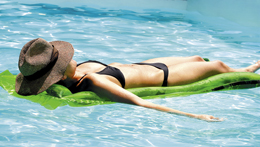
Central Oregon boasts about its sunny weather. But it also has one of the highest rates of new melanoma diagnoses in the country.
The most deadly form of skin cancer, melanoma can be prevented by staying covered. That means applying sunscreen generously and often, wearing protective clothing and avoiding excess sun exposure between 10am-4pm.
Protection from the sun is especially important for babies and children, who are much more sensitive to the sun than adults. Just one blistering sunburn in childhood more than doubles a person’s chances of developing melanoma later in life. In fact, about 80 percent of a person’s lifetime sun exposure happens before age 18.
“We always counsel people to cover up to protect themselves from sun damage, but when you get to the pool, especially for kids, sunscreen is often the last thing on the mind,” said Lizzi Katz, cancer education coordinator for St. Charles Health System.
To help protect the public from skin damage, St. Charles Cancer Center and St. Charles Family Care have teamed up to install sunscreen dispensers at Juniper Swim and Fitness Center, near the outdoor pool; Redmond Parks and Recreation’s Cascade Swim Center and at Crook County Parks and Recreation’s Prineville swimming pool.
The dispensers — which feature Skin Alive, a high quality, water-resistant broad spectrum sunscreen offering UVA and UVB protection — are available for use by both swimmers and staff. PABA and paraben free, Skin Alive’s mineral foundation is made of zinc oxide and titanium dioxide. Each dispenser holds two liters of product, which equates to about 150 applications.
According to the Oregon Division of Public Health, the state’s melanoma death rate was the eighth highest in the country during the years 2000 to 2006. In that same time period, the rate of new melanoma diagnoses in Oregon was the fourth highest in the United States, or 36 percent higher than the national average. Deschutes and Crook Counties had the second and fourth highest rates in the state.
“With skin cancer rates on the rise, especially in the high desert, we need to change our mindset about protecting our skin,” Katz said. “By making a quality product available for a vulnerable population — kids and adults who are out to enjoy the summer weather — we can offer convenient, no-cost protection to our community.”




